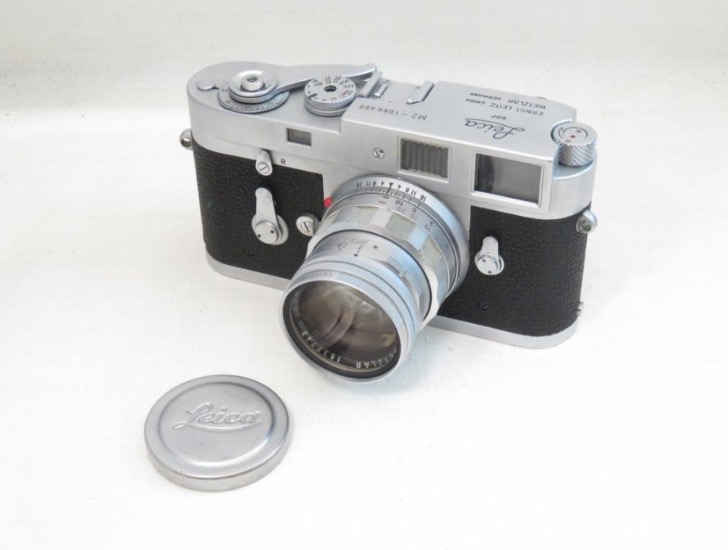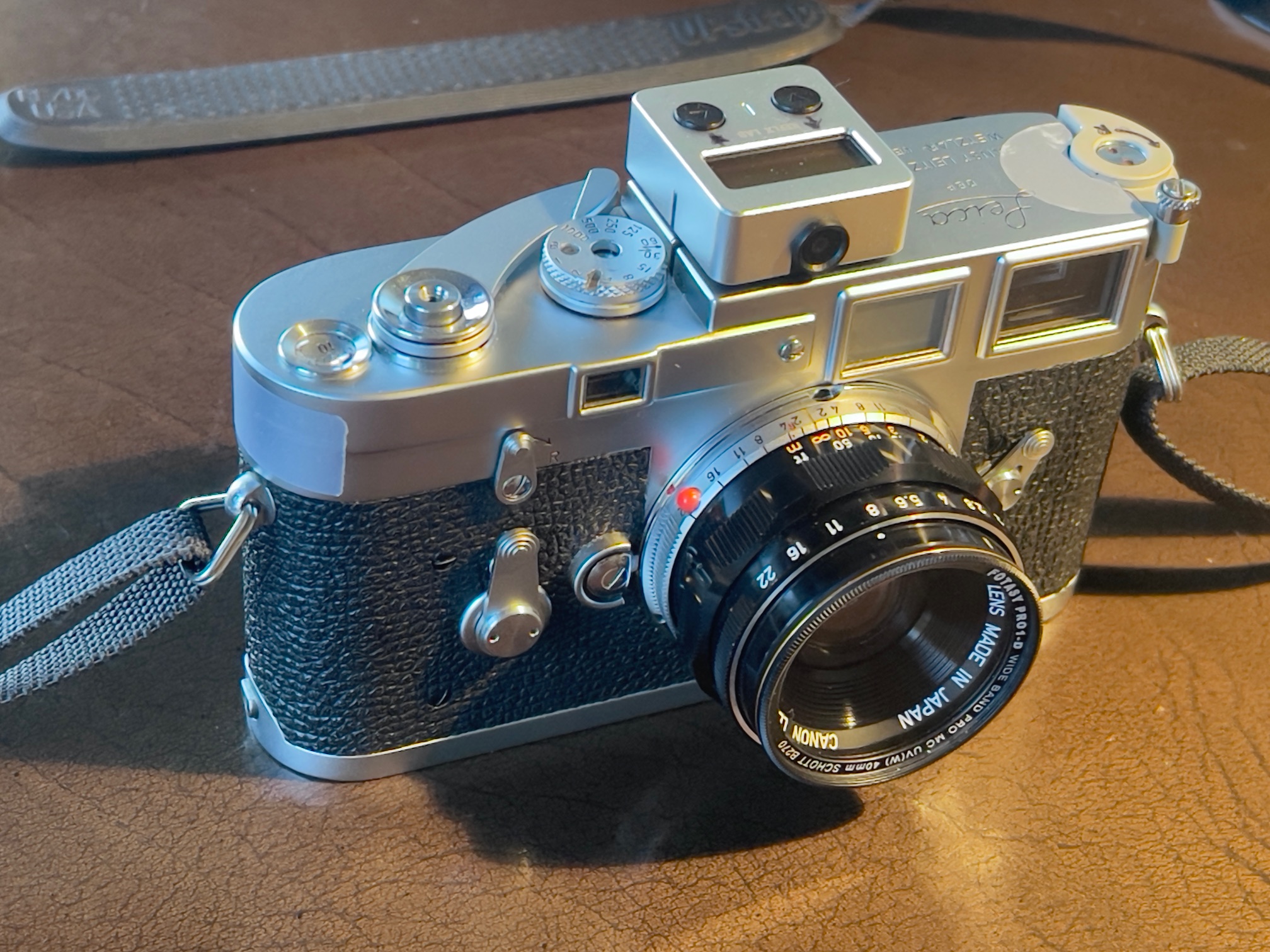A troubled history leads to a fine camera.
For an index of all Leica-related articles click here.
I bought a used Leica M10 the other day. What follows details how I got there.

Just arrived.
Leica’s understanding of the digital landscape was tortuous and error prone to state it mildly.
Leica M digital history: Their first effort, the Leica M8 in 2006, very late to market, used a Kodak (!) 10mp sensor and was a miscue, as it used a cropped sensor. For goodness’ sake, one of the prime reasons to use a Leica is the 35mm lens. Suddenly it was 50mm because of the crop. And your exotic 21mm became a mundane 28mm. As with all digital Ms the shutter is now metal and vertically running. The body is 14% thicker than that of the film Leica. In its defense I suppose the M8 did force Leica into learning how to make a digital camera with the M8. It just was not a very appealing one. To add insult to injury Kodak got the specs for the sensor’s cover glass wrong resulting in Leica having to offer free IR filters to owners to try and reduce poor rendering of dark fabrics. And that’s before mentioning the maximum ISO of 640 (seriously) and random lock-ups like a Windows computer of yore. A hot mess.
Then came the Leica M9 which was their first full frame sensor effort. But someone at Leica chose a manufacturer seemingly clueless about sensor engineering (yup, Kodak again) and after a while their sensors developed corrosion, rendering the camera useless. And, of course, there are no spares.
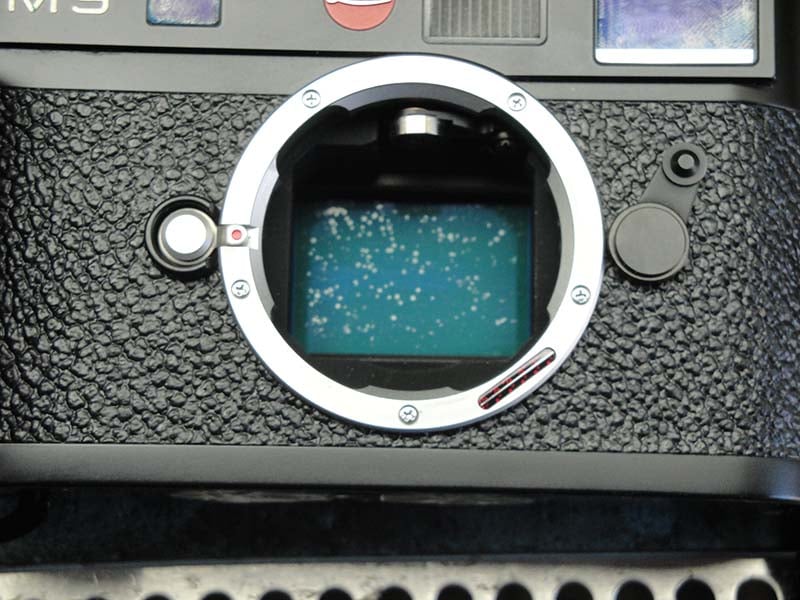
Corroded sensor in an M9.
There’s a repair shop which fits aftermarket sensors …. for $2,500. The technical information regarding the causes of corrosion is very well written on that site and recommended to all Leica M9 owners. Now that’s what I call a repair bill. Both the M8 and M9 used CCD sensors whose colors I love (my APS-C Nikon D2x used one), but the trade off is grain and a lower dynamic range compared with CMOS designs. The M9’s CCD sensor had 18mp. Nice, but the shutters in the M8 and M9 were Nikon DSLR noisy and the garish large ‘M9’ script on the front of the top plate just added embarrassment to loudness, the latter courtesy of that red dot. Surprisingly aftermarket replacement batteries are listed by Amazon.
It gets worse. Much worse. The next effort was the strangely named Leica M240 which now exceeded the size of the lovely film M body because another dope at Leica decided to add video. This porker was no less than 25% thicker than the film cameras. The sensor was designed by a Belgian company named CMOSIS and made by STMicroelectronics in Grenoble. Video in a street snapper. Uh huh. But that’s far from the worst of it. You see the aftermarket never made batteries for the camera as the market was too small to justify the tooling costs and, yup, you guessed it. Leica no longer makes the battery, so every M240 will soon be an $8,000 paperweight.

The M240 $8,000 paperweight. Fat and useless.
No, you will not find it on Amazon and Hung So Low sure as heck is not making it. It was Leica’s first effort with a CMOS sensor and had no corrosion issues. M240s can be had for under $3,000 but once the dire battery situation gets recognized they will quickly fall to zero. Worthless. If there was one really good technology development in the M240 it was Leica’s inspired crafting of a series of conical micro lenses to address and correct color fringing issues with wide angle lenses. Now that was genius indeed.
Finally the Leica M10 came along in 2017, priced at $8,995. The sensor was made by the same Belgian company as for the M240. The shutter was now reasonably quiet, like on the M3 of 1954. 24mp, a battery which is still made, no useless video, and the size was almost back to that of the M3. The heights are now identical but the M10 is still 16% (5.5mm) thicker. The button count was reduced and someone is cleaning up selling replacement stick-on logos to cover that ridiculous red dot which screams ’steal me now’. There are two things to dislike about that unnecessary red decoration. First, it screams nouveau riche when all the self effacing street snapper wants is oldveau pauvre. Second, it loudly announces ‘Steal Me Now’. The shortest shutter speed is 1/4000th and there is no electronic shutter. I bought a replacement for the red logo from AGS Supply. It looks like the screw on the M10-P but is actually retained with two-sided sticky tape, just like the red dot. Silly expensive but the alternative of a piece of tape would be an insult to the gorgeous body. The M10 is now discontinued.
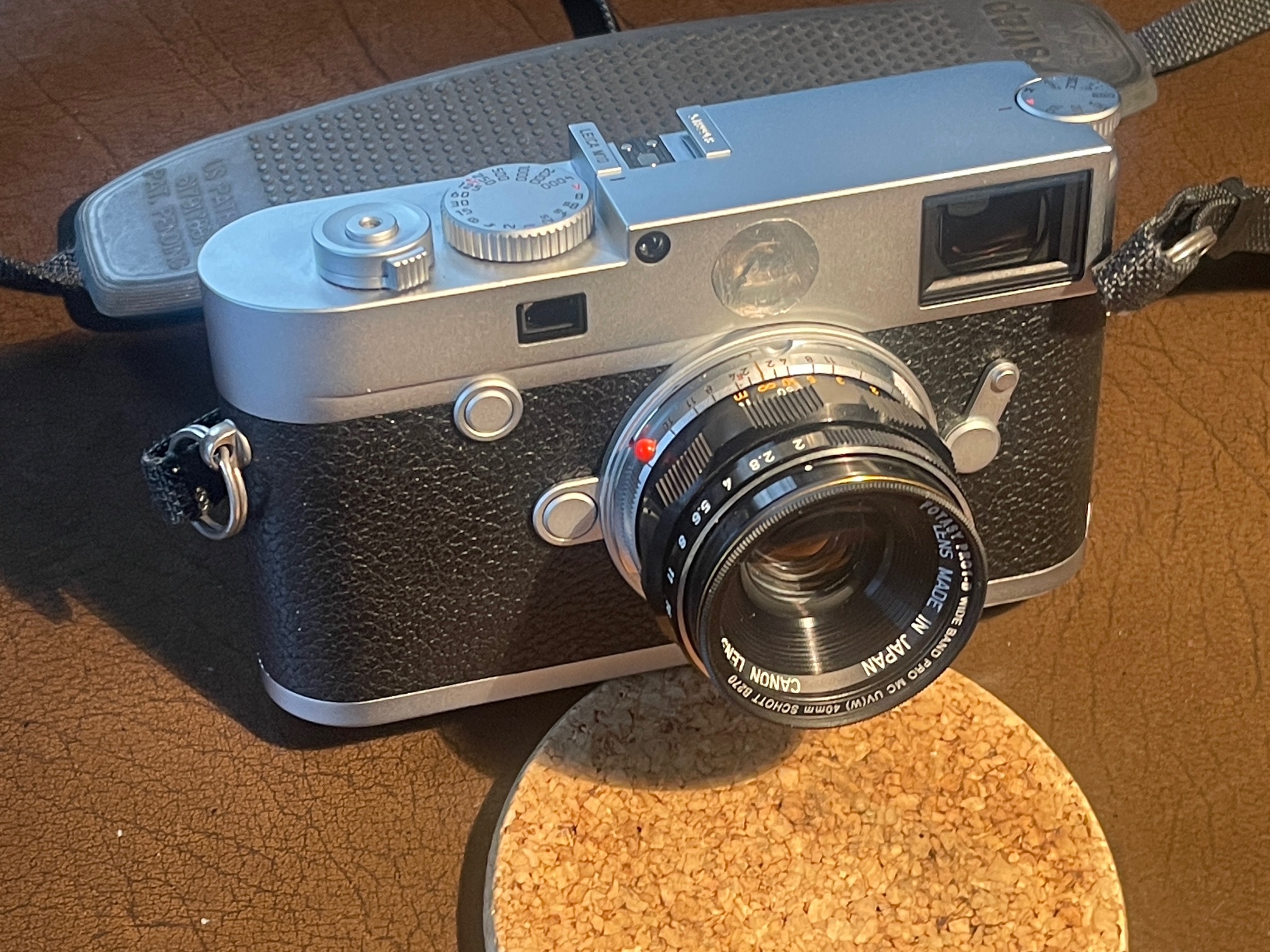
The silver tape covering the garish red logo will have to do for now.
The guiding design ethos of the Bauhaus remains, first seen in the 1954 M3.
One interesting variant was the M10-D which deletes the rear LCD, harkening back to film days. I would much prefer this over the stock version, but do you really expect me to pay $2,000 more for less? The M10 was the first digital M that spoke to me on paper, but it required too much paper to buy. I decided to wait, knowing that digital devices lose value faster than a newly minted politician loses his integrity.
With the Leica M11, introduced in January, 2022, also at $8,995, Leica finally knocked it out of the park with a 60mp sensor, switchable to lower settings of 36mp or 18mp. The added sensor Back Side Illumination saw the already good dynamic range of the M10 grow by almost 2 stops. But who needs 60mp? And at almost $10,000 now without a lens you need a really good spell in the market not to feel the pain. Or wait three years for used prices to halve, like with the M10. It’s unclear who makes the sensor for the M11 but given that Sony invented BSI technology it may well be the Japanese company. The M11 offers a silent electronic shutter option for the first time. Nice. That I would like to have in the M10. There’s also 64gB of internal storage so you do not even need SD card and that 64mB will store at least 2,000 DNG/RAW files. Phew! But, then again, a 64gB SDXC card costs all of $15 so if you are buying the M11 for its internal storage a prior visit to your shrink is probably advised. It’s a current model so wait three years after it’s discontinued to snap one up at 50 cents on the dollar.
Well, here’s hoping that they keep making batteries for ‘my’ M10, even if they are ridiculously priced. The user’s manual states that batteries are only good for a scant 4 years.
Cost: But the elephant in the room is the cost of a good used M10. Even 5 years after it was discontinued it’s still silly expensive. A good user film M2/M3/M4 can be had for $1,600 so the M10 is almost thrice as much. You will not find one for less than $4,500. The way I rationalized this outlay was simple. It’s equivalent to 110 rolls of processed and scanned film. Film is as ridiculously expensive as the modern digital M. 110 rolls is not a lot. Mine came from an authorized Leica dealer with a 12 month warranty and a spare battery. Nice, as the M10 is reputed to be something of a battery hog.
One snag is that when it comes time to sell the M10 for something newer, it will have significantly depreciated from today’s cost whereas the film M bodies, if history is any guide, will continue to keep pace with inflation. That’s a sad fact of throwaway digital technology. At some point in the future there will be no key replacement parts for the M10 just as there are no batteries for the M240.
Why did I upgrade from film after returning to the Leica M3 after a 20 year absence from the brand? Well after running a few rolls of Kodak Ektar through it two things became clear. Large 13″ x 19″ prints from the scanned full frame were perfectly feasible. But start cropping and the resolution of the scanned file is simply inadequate. And that even applies to the highest quality scans made with a 36mp Nikon D800 and a dedicated ‘scanner’ setup. The scan was running out of resolving power way before the lens did and, let’s face it, who wants to depend on the tender mercies of the USPS and the interminable wait to get the mediocre scanned results from a commercial processor?
Knobs and buttons: The design philosophy of the M10 could not be more different from that of the typical DSLR. On my Nikon D800 I count no fewer than 15 physical controls on the back plus another 11 on the front for a total of 26.
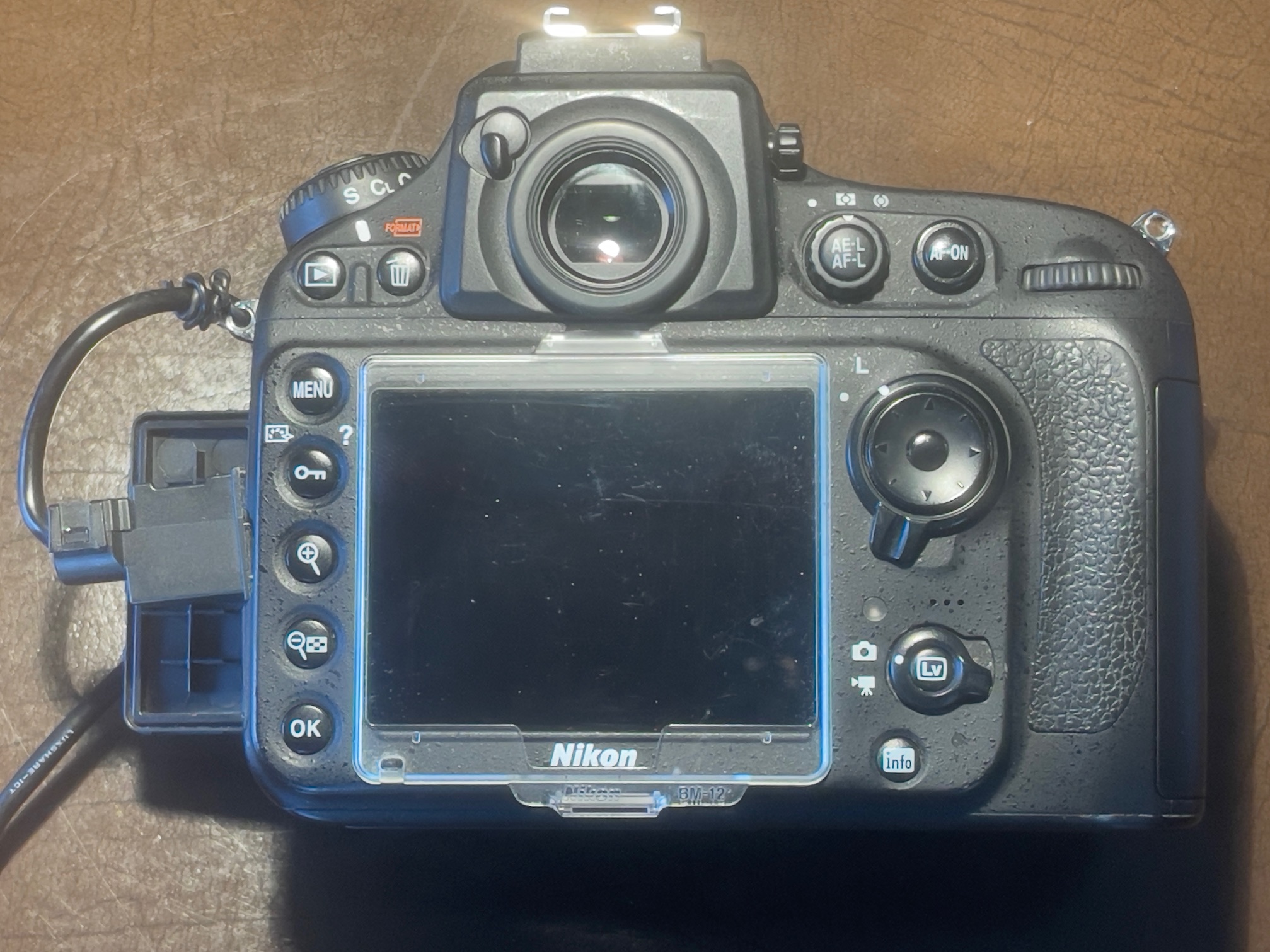
Control madness – the rear of the Nikon D800.
Compare with the rear of the M10:
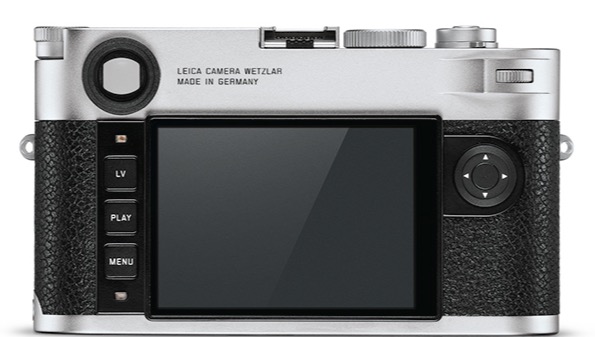
Severity and simplicity – the rear of the Leica M10.
The front adds just 3 controls. The design philosophy of the Nikon takes as many controls from the LCD to the body as is possible but in practice I find you set your favorite settings and hardly ever use these. The M10 allows you to place a handful of favorite settings on the screen which is first seen on the LCD when ‘Menu’ is pushed. Thereafter a second push on the Menu button gives you the myriad of settings which digital cameras revel in. Minimalism trumps maximalism in my book.
Resolving power: Some examples in later installments of this piece will show the true resolving power of my four M lenses – the 35mm Leitz Summaron f/3.5 RF, the 35mm Canon LTM f/2, the 50mm Canon LTM f/1.4 and the 90mm Leitz Tele-Elmarit f/2.8. In aggregate these cost me less than one modern used Leica lens and I rather suspect that the costliest, the 35mm Summaron, will be up for sale soon, the goggles a needless and clunky reminder of the limitations of the M3’s viewfinder, as the M10 has native frames for the 35mm Canon, which also happens to be 1 1/2 stops faster.
A related reason is that exposure measurement with the M3 is too slow for the street candid work I favor and, by contrast, every digital M body comes with aperture priority auto exposure. Sure there’s still no autofocus but with the speedy rangefinder and zone focusing that’s not a serious impediment to fast work. Yes, there’s no IBIS but I don’t miss it. I’m (still!) steady enough. And the alternative of using my Nikon D800 with its immense mass and weight for discrete street work does not solve.
In Part II I will look at the mysteries of 6-bit lens coding, proper rangefinder alignment and other arcana.









